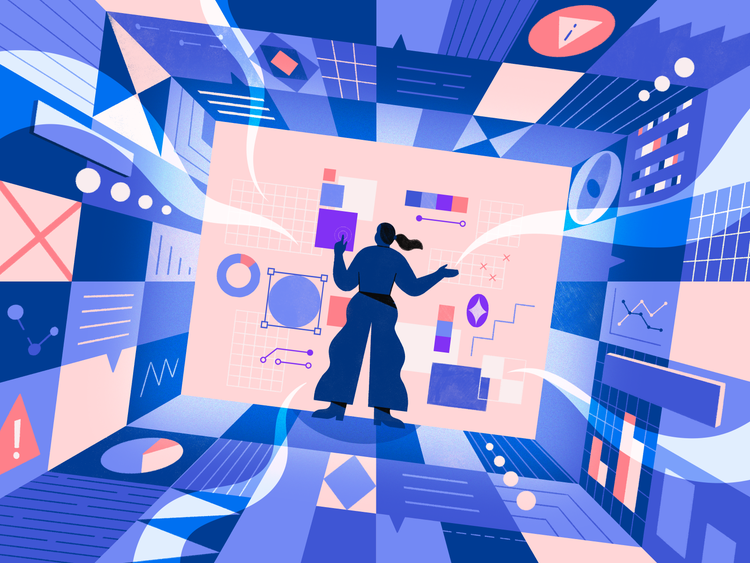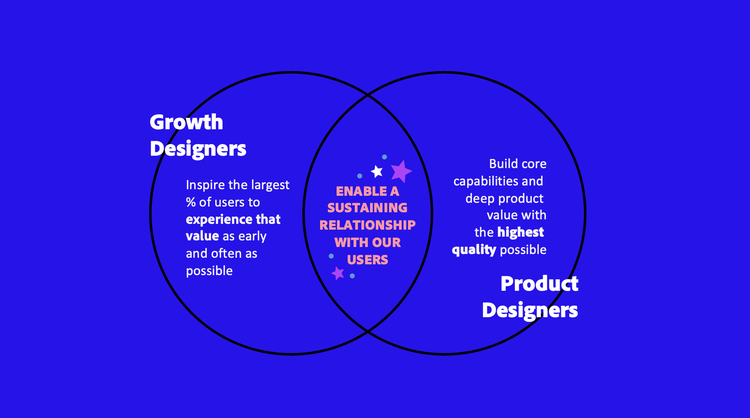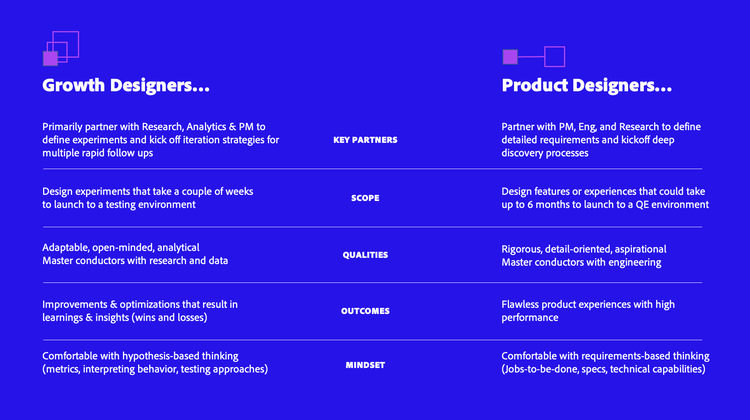The emergence of the growth designer
A close-up look at this new(ish) design specialization

Illustration by Beatrix Hatcher
Fast forward eighteen years. I throw dinner parties often and with each passing year my tools have gotten better and my skills more advanced. But the biggest evolution was to my workflow: I eventually learned to optimize planning and sequence steps to create exactly the environment I wanted for me and my guests—a memorable and delicious canvas for making new memories, while also being able to participate in the party myself.
Growth designers are like great dinner party hosts: We turn dials, flip switches, and look for meaningful ways to make in-product experiences seamless. Over the last five years, there’s been a steady increase in growth design positions at companies both large and small but many people (even those in the design industry) don’t know what the field entails, how growth designers work alongside product teams, and what qualities make people shine in their roles.
What exactly is growth design?
Although it’s a relatively new field, many designers have been approaching their work with a growth mindset for quite some time. Growth design expands on the human-centered problem solving process by using scientific methods to improve business methods. Where core product design uses customer insights to conceptually solve design problems, growth design observes and experiments with customer behavior to scale improvements. Together they create meaningful experiences.

I lead the growth design team for Adobe Express. We have a global team and four areas of focus:
- Optimization: Understanding drop-offs, bottlenecks, and closing gaps to reach performance goals. We lean heavily on data to identify and prioritize the bite-sized ways we can make the current experience more seamless.
- Experimentation: Approaching known problems and opportunities in a current experience in new ways, powered by new customer insights, emerging patterns and behaviors, and market research.
- Innovation: Identifying and building high level concepts for product or business transformation to push boundaries, disrupt current markets, and get ahead in new ones.
- Impact: Socializing insights and knowledge back to our cross functional and core product partners to influence strategies and product building.
While product designers work deeply on creative product features, capability, and value, growth designers work in squads across the product funnel at different stages of the customer journey:
Acquisition: In a dinner party world these are the invitations and the front door. Someone has a creation goal (for example, an Instagram story about their small business) and they’re searching for a tool to make it. Acquisition includes all the places people can learn about Express before trying it—Adobe.com, SEO pages, app stores, partnerships, the community, and social/business networks—and get their first impressions of our product. During this time, they’re evaluating whether it’s worth further exploration. Great acquisition surfaces are approachable and simplify their decision making. It’s akin to helping people with the choices they must make between accepting an invitation and arriving at a party (like knowing what to wear, what to bring, and the vibe of the party).
Activation: Once someone has signed up to check out our product, these are the interactions and experiences that comprise their very first visit. In Adobe Express it’s understanding what people want to do, orienting them with the editor and the features, and assuring they can successfully create a first project. At a dinner party it’s taking someone’s coat, getting them a drink, and introducing them around so they feel comfortable and welcome.
Repeat engagement: After someone’s made their first project, re-engagement is about building and sustaining a relationship with them. It can extend for weeks, months, and years but it starts from the moment someone anticipates what they might want to create next in Express. At a party, it’s those moments when you click with others over common interests, make plans for a future hangout, or ask the host for their recipe. You're invested.
Monetization: Present at every stage, monetization is about helping customers discover a product’s full value (in our case, a paid subscription, premium features and content, and more time saving efficiencies), and assisting them with decisions about what they need most. We want people to discover their full potential at any stage of their journey. At a party, it’s the way the host reads the room and energy, makes thoughtful introductions, and adjusts the environment to make sure everyone has what they need.
How growth designers work alongside core product design teams
Companies are realizing that product-led growth is key to maximizing customer success and building meaningful relationships in a world where people have other options. While core product design teams build deep offerings, capabilities, and internal innovations, growth design can provide a temperature check on changing trends, the reality of engagement, user comprehension, and customer behaviors. Both designers work closely together, and their motivations, intent, and measures of success differ to insure complementary impact.

The companies that are doing the best job of setting up successful growth organizations understand that a growth designer is a strategic partner for product teams. Those partnerships begin with product managers who work closely with design, research, and data analyst partners to write hypotheses for product improvement (for example, examining why customers are dropping off at a specific moment in the current experience).
The growth squad gathers known qualitative and quantitative insights to help inform the best experiment design: Should it be an A/B test (two new versions of an experience), a Control vs. Variant test (the original experience against another), or a Just Do It test (release it in the product and see what happens)? Researchers investigate what we need to know more of, and help designers decide how best to approach designing the experiment so the flow will result in clear data or insight.
Growth designers then work with engineering to build and launch the project to a testing environment (not all current users will see the experiment). It’s critical to not jam too much into a design, otherwise it may be difficult to understand what about the experiment performed well or failed (was it the copy, the flow, the visuals?) Similarly, it’s important to not stay so “safe” that the results don’t produce strong enough learnings. Once results are back, all functions of the growth squad interpret and discuss the results together. Experiments with significantly positive results are shared with core product managers and designers so they can be released more permanently and experiments that are flat or negative contribute to our knowledge bank—we refine the hypothesis, iterate on the design, and try again.
Qualities that make the best growth designers
Since Growth Design is new by name, it can be hard to find team members who already have direct experience with it. On the Express team, all our growth designers started as product or visual designers. What sparked their interest in growth design was an appetite for learning how designs perform, enthusiasm for fast, iterative creation cycles, and analytical mindsets. I have found that the most successful Growth Designers thrive and are most successful when they can:
Balance quality standards with design humility. Don’t be too precious with your design ideas. You may have the most intuitive, considered concept, but users might not be ready for it, the hypothesis might not be right, or its success could hinge on solving some other part first. Maintain high quality standards for your designs, but stay curious and open minded about alternative solutions.
Embrace failures. Growth design is all about learning, so significant wins and significant losses mean you’ve done your job well. Failures define the bookends and boundaries of our product experience—customers may say they desire one thing, but their actions can expose other needs and goals. Negative experiment results help us refine our design principles, invalidate faulty assumptions, and more deeply understand our customers.
Strongly advocate for the best user experience… with backup. In any product organization, it’s not always possible to launch things exactly as we wish. Technical limitations, timing consideration, and tradeoffs all exist, and we must work around them. But growth designers have a special card in their back pockets: Their partnership with data and research. It’s hard to negotiate or significantly de-scope a design decision when data strongly supports it, when the experiment environment makes it much less risky, when customers are asking for it, and when short timelines change tradeoff discussions to when, not if.
See user engagement like a conversation. You’re at one of my dinner parties for the first time. I open the door, say hi, take your coat, and then I ask, “How are you liking the party so far?” Huh? It sounds ridiculous but people frequently get similar messaging when signing into an app the first few times—rate our product, opt-in to our mailing list, enable notifications—even though they haven’t been there long enough to make those decisions. Growth designers strive to create conversations so all product interactions, modals, and messages are relevant to where they are and what they need in the moment.
Be holistic and understand how one change can have a domino effect elsewhere. Because we work across a product’s customer funnel, and not deeply in one product capability, we see how even our best efforts in one area can cannibalize another. Maybe an experiment resulted in 40% of people finishing their first project, but we saw repeat use or conversion drop. Is this a drop we’re willing to live with? Why is it happening? A good growth designer can balance key business metrics and customer needs to make decisions about how to move forward. We strongly believe in avoiding dark patterns because meaningful growth happens when you inspire users, not convince them.
It takes both product and growth designers to create and host memorable experiences. In the world of dinner parties, when the product designer bakes the perfect chocolate cake, the growth designer reads the room and vibe, observes when everyone is ready for it, and serves the right portions and accompaniments to maximize its enjoyment.
Adobe Express Growth Design is hiring and we’re looking for curious, entrepreneurial, and customer-passionate people. If you think growth design might be a good fit for you, review our job postings.